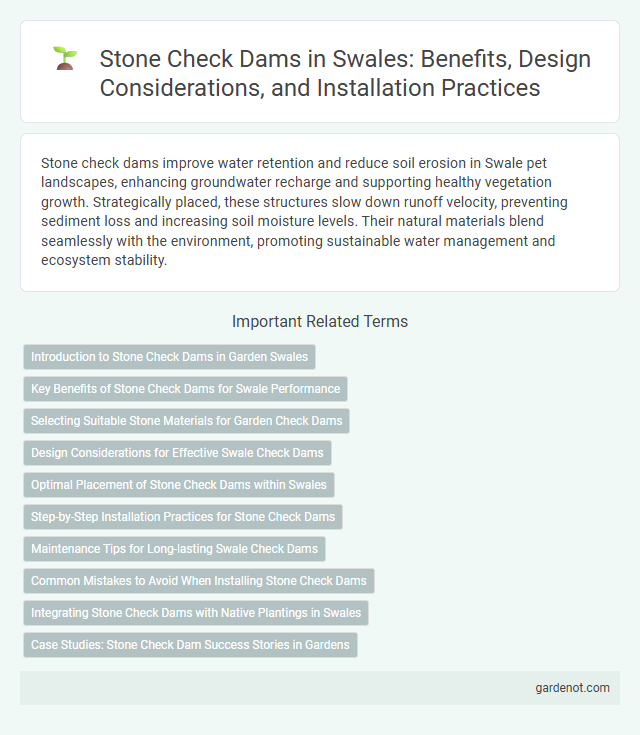Stone check dams improve water retention and reduce soil erosion in Swale pet landscapes, enhancing groundwater recharge and supporting healthy vegetation growth. Strategically placed, these structures slow down runoff velocity, preventing sediment loss and increasing soil moisture levels. Their natural materials blend seamlessly with the environment, promoting sustainable water management and ecosystem stability.
Introduction to Stone Check Dams in Garden Swales
Stone check dams in garden swales serve as effective erosion control structures by slowing water flow and promoting sediment deposition. These small, strategically placed rock barriers enhance water infiltration and reduce runoff velocity, protecting soil integrity. Their integration into garden swales supports sustainable water management and landscape stability.
Key Benefits of Stone Check Dams for Swale Performance
Stone check dams significantly enhance swale performance by reducing water velocity, promoting sediment deposition, and improving infiltration rates. These structures prevent soil erosion, maintain channel stability, and support vegetation growth, which increases the swale's capacity to manage stormwater runoff effectively. Improved water retention and filtration from stone check dams contribute to better groundwater recharge and reduced downstream flooding risks.
Selecting Suitable Stone Materials for Garden Check Dams
Selecting suitable stone materials for garden check dams involves choosing durable, weather-resistant stones such as granite, basalt, or limestone to ensure long-term structural integrity. Stones should be appropriately sized--typically between 6 to 12 inches--to effectively slow water flow and reduce soil erosion within swales. Properly selected materials promote efficient water retention and support vegetation growth, enhancing the overall function of the check dam.
Design Considerations for Effective Swale Check Dams
Effective swale check dam design requires careful consideration of materials, height, and spacing to maximize water retention and minimize erosion. Stone check dams should be constructed using durable, locally sourced rocks stacked securely to withstand flow velocities typical in swales. Properly designed check dams facilitate sediment deposition, enhance groundwater recharge, and reduce downstream sediment transport.
Optimal Placement of Stone Check Dams within Swales
Optimal placement of stone check dams within swales enhances sediment capture and controls water flow velocity, preventing erosion and promoting groundwater recharge. Positioning dams at strategic intervals based on slope gradient and soil type maximizes their effectiveness in stabilizing swale channels. Properly spaced stone check dams reduce peak runoff and improve the swale's capacity to manage stormwater sustainably.
Step-by-Step Installation Practices for Stone Check Dams
Step-by-step installation practices for stone check dams in swales begin with site assessment to identify erosion-prone areas and determine appropriate spacing. Next, placing large, angular stones tightly together across the swale ensures a stable barrier that slows water flow and promotes sediment deposition. Finally, compacting soil around the stones and integrating vegetation enhances structural integrity and prevents undercutting.
Maintenance Tips for Long-lasting Swale Check Dams
Regular inspection of stone check dams in swales ensures structural integrity by identifying and repairing erosion or displacement early. Clearing accumulated sediments around the dam promotes efficient water flow and prevents overflow damage. Using locally sourced, durable stones for repairs enhances longevity and maintains ecological balance within the swale ecosystem.
Common Mistakes to Avoid When Installing Stone Check Dams
Improper placement and spacing of stone check dams often lead to ineffective water flow management and increased erosion within the swale. Using stones that are too small or loosely packed can result in structural failure during heavy rainfall events. Overlooking regular inspection and maintenance causes sediment buildup, reducing the dam's ability to slow water and maintain soil stability.
Integrating Stone Check Dams with Native Plantings in Swales
Integrating stone check dams with native plantings in swales enhances erosion control and promotes groundwater recharge by slowing water flow and stabilizing soil. Native plants, adapted to local climate and soil conditions, improve sediment capture and provide habitat for beneficial wildlife while reducing maintenance needs. This combined approach optimizes swale performance for sustainable stormwater management and ecosystem resilience.
Case Studies: Stone Check Dam Success Stories in Gardens
Stone check dams in gardens effectively control erosion and improve soil moisture retention, as demonstrated in case studies from urban landscapes in California and Rajasthan. These structures create micro-watersheds that support native plant growth by slowing water flow and enhancing sediment deposition. Results include increased vegetation density and reduced surface runoff, contributing to sustainable garden ecosystems.
Stone check dam Infographic

 gardenot.com
gardenot.com